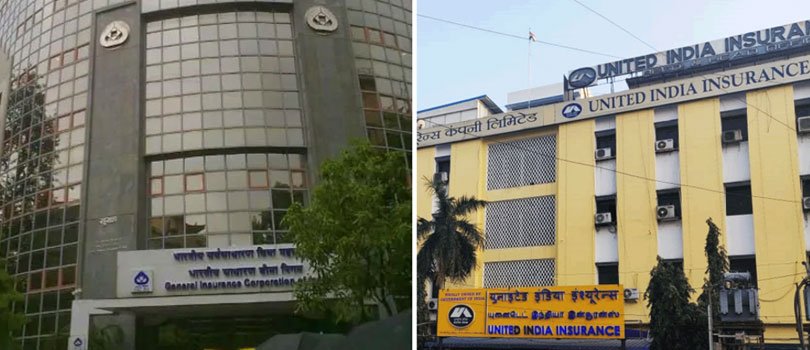 24-02-2021
24-02-2021
Privatisation of Public Sector General Insurance Companies – Any Takers?

 Insurance Alertss
Insurance AlertssPrivatisation of Public Sector General Insurance Companies – Any Takers?
Ever since the finance minister announced in her budget speech that the government will privatise a couple of banks and a general insurance company in the coming financial year, speculation has been rife about the possible candidates for disinvestment. There has been another major announcement, that of raising the insurance foreign direct investment (FDI) limit to 74% which will indeed have a far-reaching impact on the insurance landscape in India. The rise in FDI cap merits a separate assessment, this article attempts to examine the likelihood of success of the privatisation effort.
What is not clear from the announcement is the reason for taking this step. Is it merely to meet the budget deficit, or is this the outcome of a paradigm shift that the government has no business to be in business? Or the decision to privatise is driven by the government’s inability or unwillingness to keep pumping more and more capital in government-owned general insurance companies?
Readers may recall that this writer had argued in a related article nearly a year ago (Moneylife 6 January 2020) that the then proposal to merge three of the four government owned companies and make a capital infusion of rupees 10 to 12 thousand crores simply did not carry any strategic rationale.
Apparently, the government has moved on as is evident from the announcement to privatise one company, which may well be the first step towards privatising the other two fully government-owned companies. Whatever be the reason and the roadmap, it is useful to examine how the privatisation might play out. An initial public offering (IPO) does not seem workable – the example of another government owned insurer’s IPO would make the investors rather wary. This company’s IPO price was Rs800 and currently its share is quoting around Rs170!
There are other challenges too, mainly relating to management control. It will therefore be safe to proceed on the premise that the privatisation may take the route of a strategic sale. The one thing that would make the exercise a non-starter is the government retaining a 26% stake in the company, as the first attempt at Air India privatisation clearly demonstrated.
No Indian investor would want the government having a say in the management of the company as a 26% stake would entail. Widening the search to sell a 74% stake under the new FDI norms to a foreign buyer will raise a political storm which any government would want to avoid. However, these are stage two considerations, the primary question being: is there a compelling business case for any investor, strategic or otherwise, to buy one of the government owned insurance companies. There were 28 private sector insurance companies including standalone health insurers in the market as on 31 March 2020 (a couple of mergers and acquisitions have taken place since). Attractiveness of a public sector company for its license is rather faint since it is not difficult to secure a fresh license if a new entrant meets the regulatory criteria. The second point of attraction – getting an established customer base and a nationwide footprint - is equally dubious.
General insurance policies are annual contracts and customer loyalty is rather fickle. For a majority of customers, whether retail or corporate, price is the sole criteria. The value of its distribution networks is equally febrile, since most intermediaries only go by the remuneration paid by the insurance company - the highest commission payer gets the business despite the fact that there are regulatory norms about intermediary remuneration. And in this age of technology, a nationwide brick and mortar branch network can be a liability instead of an asset.
A look at any of the privatisation candidate shows up the challenges. A recent item in a financial newspaper says that the government is considering General Insurance Corp of India (GIC) and United India Insurance for privatisation. If true, this goes beyond the government’s declared intention of privatising one company. However, it may be instructive to examine the named candidates. GIC receives a 5% mandatory cession (in plain English, 5% share of business written by any onshore general insurance company). This is by and large profitable business since the commission paid by GIC in respect of this business is much less than the acquisition costs incurred by the primary insurer. However, after privatisation, there will be no rationale for compulsory cession, which will shrink GIC’s premium income substantially.
Secondly, GIC writes considerable amount of international reinsurance business mainly on the back of the (implicit) sovereign guarantee, which will disappear after privatisation and will therefore impact its business prospects negatively. Lastly, as the received wisdom goes, insurance company financials are rather opaque, reinsurance companies’ even more so.
Talking of financials, let us now examine the case of the company being speculated about for privatisation. Before doing that, a couple of disclaimers will not be out of place. Firstly, this company’s financials are more or less representative of what afflicts the financials of other government insurers. Secondly, and contrary to the prevailing narrative, what ails these companies is not incompetence of the management but the ‘departmentalisation’ of these companies under government ownership over the years.
The writer has had the opportunity to work with the past and current senior management of these companies and can affirm that the persons in leadership roles were/are by and large first-class professionals with impeccable integrity. Since the intent here is to shed light on the inherent weaknesses of the financials of public sector general insurers, it will be useful to start with the consolidated numbers relating to public sector insurers’ performance in FY19-20 as per the Insurance Regulatory and Development Authority (IRDAI) report. Public sector insurers’ market share shrank to 38.78% in FY19-20 from 40.52% in FY18-19. Overall underwriting loss of public sector insurance companies was 32.38% as against an average of 6.56% for private sector.
In layman’s terms this means that for every rupee of premium income, public sector companies lost Rs1.32. Insurance companies generally expect to recoup their underwriting losses via their investment income. After taking into account the investment income, public sector companies reported a loss of Rs5,701 crore in FY20-21, up from Rs3,288 crore in FY18-19.
In comparison, the private sector, excluding specialised health insurance companies reported a profit after tax (PAT) of Rs4,037 crore, up from a PAT of Rs3,584 crore in FY18-19. The reasons are not far to seek. Public sector companies are forced to write even unprofitable business to maintain their cash flow in order to cover their operating costs, mainly salaries. It is informative to look at the two largest classes of business in the industry - Motor and Health. The claims ratios of the private sector companies in FY19-20 in Motor and Health respectively were 77.95% and 72.55% as against that of public sector companies’ 96.54% and 102.91%, respectively.
Looking at the public sector company mentioned in the news report, its overall losses in FY19-20 were Rs1,485 crore, after considering the investment income. Its balance sheet was virtually eroded since the solvency margin of the company at the close of financial year was 30% of the regulatory requirement. The government had to infuse around Rs1,100 crore in this company in the current FY to meet solvency norms. Its audit report makes interesting reading. Under-provisioning for bad and doubtful loans to the likes of Infrastructure Leasing & Financial Services (IL&FS), Dewan Housing Finance Corporation Ltd (DHFL), Reliance Home Finance and Reliance Capital was around Rs390 crore.
While this has been done with regulatory forbearance, the main challenge for any acquirer is another, bigger number in the financials. The largest under-provisioning was towards employee pension contributions. A section of all public sector insurance companies’ employees is entitled to a ‘defined benefit’ pension, and the overall liability of Rs1,265 crore on this count was underprovided to the extent of Rs1,012 crore, to be amortised over the next four years!
This highlights the biggest challenge facing any potential buyer: employee numbers. The total number of employees as on 31 March 2020 was around 14,000, most of whom are possibly entitled to a defined benefit: pension. A good indicator of sustainability of a business is cash flow. The operating cash flow of this company was negative Rs2,627 crore, which was largely covered by sale of investments of around Rs2,375 crore.
Talking of investments, the main attraction for buying any insurance company is its investments such as equity, bonds and immovable property. The market value of equity portfolio of this company as on 31 March was Rs6,200 crore. The book value of total investments was nearly Rs28,400 crore, which includes policyholders’ funds of around Rs26,100 crore. There has been some criticism of the earlier privatisation of government companies such as Hotel Corporation of India and Videsh Sanchar Nigam Ltd (VSNL), mainly highlighting the fact that the buyers made windfall profits on sale of real estate that came with these companies.
A cursory look at the real estate holdings of the insurance company will provide some insights. It is a given that most insurance companies own substantial real estate, mainly office and residential buildings. This company’s brick and mortar holdings are currently valued at around Rs81 crore but are possibly worth more. However, these do not offer easy liquidity to a potential acquirer because of the age and tenancy related issues. Unlike manufacturing companies, insurers’ landholdings are rather meagre – the gross block of the freehold landholding of this company is Rs12 crore. Ascertaining its attractiveness is rather challenging since depending on the location and encumbrances, market value of landholdings might range from a few hundred crore to a few thousand crore of rupees.
These are but a few numbers, mainly as a dipstick test of the marketability of the government owned insurance companies. The attractiveness of other two government owned insurers is probably much lesser. It is therefore not inconceivable that the privatisation exercise may meet the same fate as Air India – the government may have to resort to some financial engineering to make the proposition attractive. This may include a voluntary retirement scheme (VRS) to existing employees, full commutation of defined benefit pensions and ring-fencing the under provisioning, both for doubtful investments and outstanding claims.
The idea here is not to single out any one insurer as such, but that the government cannot run businesses and ends up destroying value, for which the tax payer ultimately picks up the tab.
An out of the box solution if the government is really keen to raise revenues in a time bound manner, is to fully privatise New India Insurance, a reasonably well managed company with good brand recognition and a fair amount of international presence. This was a Tata company and who knows, perhaps like Air India, Tatas might want to get a family jewel back!
